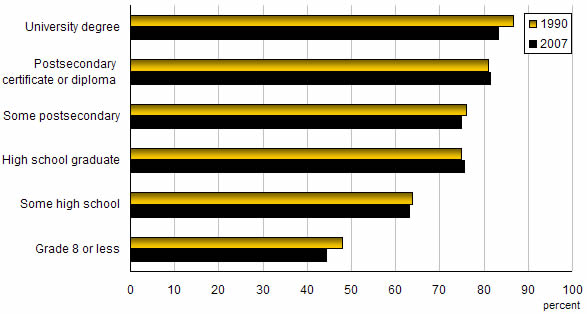Publications
The Canadian Labour Market at a Glance
Employment rates, by educational attainment
Archived Content
Information identified as archived is provided for reference, research or recordkeeping purposes. It is not subject to the Government of Canada Web Standards and has not been altered or updated since it was archived. Please "contact us" to request a format other than those available.
The employment rate increases with higher education
-
The greater one's education, the better the chances of finding work. In 2007, among people aged 25 to 64 years, the employment rate for high school graduates was 75.5%, compared with 83.2% for university graduates. Among university graduates, employment rates for people with advanced degrees, such as a master's or PhD, were slightly higher than those with a bachelor's degree. However, having some postsecondary education without having completed a program leading to a degree, certificate or diploma provided little advantage over high school graduation.
-
Similarly, higher levels of education are correlated with lower unemployment rates. In 2007, the unemployment rate was 9.5% among people aged 25 to 64 years reporting less than a high school diploma, compared with 3.5% for those with a university degree.
-
Despite the employment advantages associated with higher education, the employment rate for university graduates aged 25 to 64 years has dropped from 86.8% in 1990 to 83.2% in 2007. Employment increased for both postsecondary and university graduates during this period. However, the increase in the university graduate population outweighed their gains in employment, explaining the drop in their employment rate.
Chart F.1
Employment rates of 25- to 64-year-olds,
by educational attainment, 1990 and 2007

Source: Statistics Canada, Labour Force Survey, CANSIM table 282-0004.
- Date modified:
